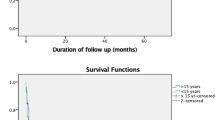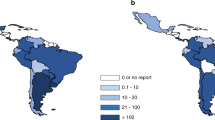Abstract
On the face of the lack of HLA-identical sibling stem cell donors for all individuals needing an allograft, the use of alternative donors is gaining popularity. Matched unrelated donors and cord bloods have become very expensive and unaffordable for most people living in developing countries. Grafting allogeneic haploidentical stem cells has become an option with a great future, mainly if the procedure is conducted in a way to cut down expenses, such as the use of reduced-intensity conditioning regimens, outpatient conduction of the procedures, and use of post-transplant cyclophosphamide. The long-term results of allografting haploidentical stem cells seem to be similar to those of grafting cord blood stem cells. The improvement of the procedures to conduct haploidentical stem cell transplantation will most likely result in more individuals gaining access to this type of treatments, critical in the current practice of hematology.
Similar content being viewed by others
References
Papers of particular interest, published recently, have been highlighted as: • Of importance •• Of major importance
Fuchs EJ. Haploidentical transplantation for hematological malignancies: where do we stand? Hematology Am Soc Hematol Educ Program. 2012;2012:230–6. A comprehensive review by an expert.
González-Llano O, Rodríguez-Romo LN, Mancías-Guerra C, Tarín-Arzaga L, Jaime-Pérez JC, Herrera-Garza L, et al. Feasibility of an outpatient HLA haploidentical stem cell transplantation program in children using a reduced-intensity conditioning regimen and CD3–CD19 depletion. Hematology. 2014;19:10–7. Description of an haplo-SCT program, using ex vivo T cell depletion with CliniMacs and conducted on an outpatient basis employing reduced intensity conditioning; expensive procedure stemming from the costs of the ex vivo procedure.
Ruiz-Delgado GJ, Mancías-Guerra C, Macías-Gallardo J, González-Llano O, Hernández-Arizpe A, Rodríguez-Romo LN, Martínez-Cabriales SA, Gómez-Almaguer D, Ruiz-Argüelles GJ. Long term results of placental blood allografting using reduced-intensity conditioning: multicenter experience in a developing country. Hematology. 2011;16:155–159. The paper describes a low engraftment rate of cord blood hematopoietic cells apparently stemming from a suboptimal quality of the cords.
Munchel A, Kesserwan C, Symons HJ, Luznik L, Kasamon YL, Jones RJ, et al. Nonmyeloablative, HLA-haploidentical bone marrow transplantation with high dose, post transplantation cyclophosphamide. Pediatr Rep. 2011;3(Suppl2):e15.
O´Donnell PV, Luznik L, Jones RJ, Vogelsang GB, Lefell MS, Phelps M, et al. Nonmyeloablative bone marrow transplantation from partially HLA-mismatched related donors using postransplantation cyclophosphamide. Biol Blood Marrow Transpl. 2002;8:377–86. First paper describing in vivo T cell depletion by means of post-allograft cyclophosphamide.
Luznik L, O´Donnel PV, Symons HJ, Chen AR, Lefell MS, Zahurak M, et al. HLA-haploidentical bone marrow transplantation for hematologic malignancies using nonmyeloablative conditioning and high-dose, postransplantation cyclophospamide. Biol Blood Marrow Transpl. 2008;14:641–50.
Godder KT, Henslee-Downey PJ, Mehta J, Park BS, Chiang K, Abhyankar S, et al. Long term disease-free survival in acute leukemia patients recovering with increased gammadelta T cells after partially mismatched related donor bone marrow transplantation. Bone Marrow Transplant. 2007;39:751–7.
Guinan EC, Boussiotis VA, Neuberg D, Brennan LL, Hirano N, Nadler LM, et al. Transplantation of anergic histoincompatible bone marrow allografts. N Engl J Med. 1999;340:1704–14.
Handgretinger R, Lang P, Feuchtinger TF, Schumm M, Teltschik HM. Transplantation of TcRab/CD19 depleted stem cells from haploidentical donors: robust engraftment and rapid immune reconstitution in children with high-risk leukemia. Blood. 2011;118:1005. Large experience with ex-vivo T cell depletion.
Jaime-Pérez JC, Heredia-Salazar AC, Cantú-Rodríguez OG, Gutiérrez-Aguirre CH, Villarreal-Villarreal CD, Mancías-Guerra C, et al. Cost structure and clinical outcome of a stem cell transplantation program in a developing country: the experience in northeast México. The Oncologist. 2015;20:1–7. A detailed analysis of SCT costs in a single institution in México which indicates that the real costs of SCT are substantially lower than those charged in many institutions in developed countries.
Bacigalupo A, Dominietto A, Ghiso A, Di Grazia C, Lamparelli T, Gualandi F, et al. Unmanipulated haploidentical bone marrow transplantation and post-transplant cyclophosphamide for hematologic malignancies following a myeloablative conditioning: An update. Bone Marrow Transpl. 2015;50:S37–9. Large experience with in vivo T cell depletion using post-transplant cyclophosphamide after a myeloablative conditioning, the long term results depending on the malignacy.
Ciurea SO, Zhang MJ, Bacigalupo AA, Bashey A, Appelbaum FR, Aljitawi OS, Armand P, Antin JH, Chen J, Devine SM, Fowler DH, Luznik L, Nakamura R, O'Donnell PV, Perales MA, Pingali SR, Porter DL, Riches MR, Ringdén OT, Rocha V, Vij R, Weisdorf DJ, Champlin RE, Horowitz MM, Fuchs EJ, Eapen M. Haploidentical transplant with post-transplant cyclophosphamide versus matched unrelated donor transplant for acute myeloid leukemia. Blood. 2015;30. A large multicenter experience.
Ruiz-Argüelles GJ, González-Llano O, Marcos-Ramírez ER, Ramírez-Cázares AC, González-López EE, Ruiz-Delgado GJ, Galindo-Becerra S, Gómez-Almaguer D. Uso de ciclofosfamida postrasplante haploidéntico en patología hematológica pediátrica. Rev Hematol Méx. 2015;16(Suppl. 1):S154. Preliminary results of a multicenter experience in a developing country with haplo-SCT using post-trasplant cyclophosphamide and a reduced intensity conditioning, the results being similar to those obtained with in vitro T cell depletion. An affordable option.
Storek J, Mothy M, Boelens JJ. Rabbit anti-T cell globulin in allogeneic hematopoietic transplantation. Biol Blood Marrow Transplant. 2015;21:959–70.
Ruutu T, Gratwohl A, de Witte T, Afanasyev B, Apperley J, Bacigalupo A, et al. Prophylaxis and treatment of GVHD: EBMT-ELN working group recommendations for a standardized practice. Bone Marrow Transplant. 2014;49(2):168–73.
Onrust SV, Wiseman LR. Basiliximab. Drugs. 1999;57(2):207–13.
Chang YJ, Huang XJ. Improving the clinical outcome of unmanipulated haploidentical blood and marrow transplantation. Bone Marrow Transplant. 2015;50(S2):S21–3. An interesting experience in non-Caucasian individuals
Di Bartolomeo P, Santarone S, De Angelis G, Picardi A, Cudillo L, Cerretti R, et al. Haploidentical, unmanipulated, G-CSF primed bone marrow transplantation for patients with high-risk hematologic malignancies. Blood. 2013;121(5):849–57.
Lee KH, Lee JH, Lee JH, Kim DY, Seol M, Lee YS, et al. Reduced-intensity conditioning therapy with busulfan, fludarabine, and antithymocyte globulin for HLA-haploidentical hematopoietic cell transplantation in acute leukemia and myelodysplastic syndrome. Blood. 2011;118(9):2609–17.
Kanda J, Lopez RD, Rizzieri DA. Alemtuzumab for the prevention and treatment of graft-versus-host disease. Int J Hematol. 2011;93(5):586–93.
Kanda Y, Oshima K, Asano-Mori Y, Kandabashi K, Nakagawa M, Sakata-Yanagimoto M, et al. In vivo alemtuzumab enables haploidentical human leukocyte antigen-mismatched hematopoietic stem-cell transplantation without ex vivo graft manipulation. Transplantation. 2005;79(10):1351–7.
Rizzieri DA, Koh LP, Long GD, Gasparetto C, Sullivan KM, Horwitz M, et al. Partially matched, nonmyeloablative allogeneic transplantation: clinical outcomes and immune reconstitution. J Clin Oncol. 2007;25(6):690–7.
Ruiz-Delgado GJ, Ruiz-Argüelles GJ. A Mexican way to cope with stem cell transplantation. Hematology. 2012;17 Suppl 1:195–7. A review on the salient features of the Mexican Method to conduct both auto and allografts.
Ruiz-Argüelles GJ, Abello-Polo V, Arrais-Rodrígues C, Bouzas LF, de Souza C, Dufort G, Gabus R, Galindo-Becerra LS, Gómez-Almaguer D, Hammerschlak N, Jaime-Fagundo JC, Jaimovich G, Karduss-Urueta AJ, Labastida-Mercado N, Nese M, Pasquini R, Seber A. Publications of bone marrow transplants in Latin America. A report of the Latin American Group of Bone Marrow Transplantation. Bone Marrow Transplant. 2015;11. doi:10.1038/bmt.2015.107. Paper which describes the prolific academic activities of Latinamerican scientists in the SCT field, one of the goals of the papers published being the simplification of allo, auto, haplo and cord stem cell grafting, stemming from the need of cost-reduction of these procedures.
Mancías-Guerra C, Ruiz-Delgado GJ, Manzano C, Díaz-Hernández MA, Tarín-Arzaga LC, González-Llano O, et al. Umbilical cord blood transplantation using non-myeloablative conditioning: the Mexican experience. Hematology. 2006;11:355–9.
Muñoz J, Shah N, Rezvani K, Hosing C, Bollard CM, Oran B, et al. Concise review: umbilical cord blood transplantation: past, present, and future. Stem Cells Translat Med. 2014;3(12):1435–43. A comprehensive review of cord blood allografting and its decay as the result of other more affordable sources of stem cells becoming available.
Vázquez-Meraz JE, Arellano-Galindo J, Mendoza-García E, Jiménez-Hernández E, Martínez-Avalos A, Velázquez-Guadarrama N, Mejía-Arangure JM. Haploidentical bone marrow transplantation in Mexico. Pediatr Blood Cancer. 2012;59(5):950–2. First paper on haplo-SCT from México.
Cantú-Rodriguez OG, Gutiérrez-Aguirre CH, Jaime-Pérez JC, Treviño-Montemayor OR, Martínez-Cabriales SA, Gómez-Peña A, et al. Low incidence and severity of graft-versus-host disease after outpatient allogeneic peripheral blood stem cell transplantation employing a reduced-intensity conditioning. Eur J Haematol. 2011;87(6):521–30. Allografting patients on an outpatient basis and using peripheral blood stem cells and a reduced intensity conditioning is associated with less frequent and severe graft versus host disease, according to this paper from México.
Ruiz-Argüelles GJ, Gómez-Almaguer D. Editorial: allografting on outpatient basis can decrease GVHD prevalence and severity. Hem Onc Today. 2012;13:8.
Solomon SR, Matthews RH, Barreras AM, Bashey A, Manion KL, McNatt K, Speckhart D, Connaghan DG, Morris LE Jr, Holland HK. Outpatient myeloablative allo-SCT: a comprehensive approach yields decreased hospital utilization and low TRM. Bone Marrow Transplant. 2010;45(3):468–75. In this paper from the United States, outpatient allografting was also associated with better results.
Svahn BM, Ringdén O, Remberger M. Long-term follow-up of patients treated at home during the pancytopenic phase after allogeneic haematopoietic stem cell transplantation. Bone Marrow Transplant. 2005;36(6):511–6. Swedish scientists have also shown that hospitals are bad places to allograft patients, since the infections and complications are worse.
Author information
Authors and Affiliations
Corresponding author
Ethics declarations
Conflict of Interest
Guillermo J. Ruiz-Argüelles, Guillermo J. Ruiz-Delgado, Oscar González-Llano, and David Gómez-Almaguer declare that they have no conflict of interest.
Human and Animal Rights and Informed Consent
This article does not contain any studies with human or animal subjects performed by any of the authors.
Additional information
This article is part of the Topical Collection on Leukemia
Rights and permissions
About this article
Cite this article
Ruiz-Argüelles, G.J., Ruiz-Delgado, G.J., González-Llano, O. et al. Haploidentical Bone Marrow Transplantation in 2015 and Beyond. Curr Oncol Rep 17, 57 (2015). https://doi.org/10.1007/s11912-015-0482-9
Published:
DOI: https://doi.org/10.1007/s11912-015-0482-9




